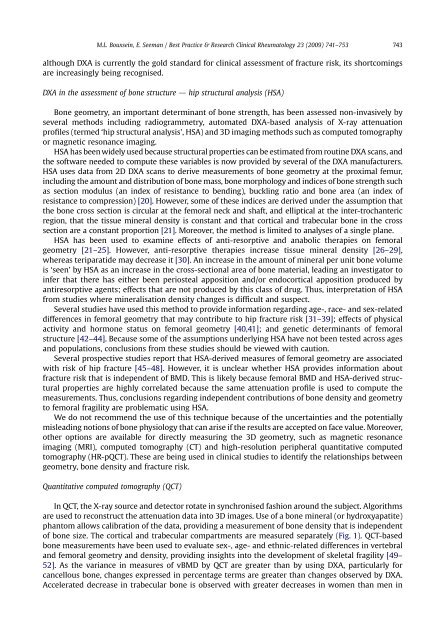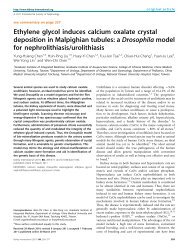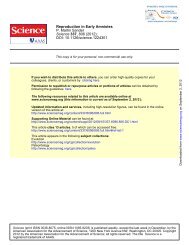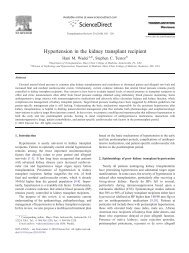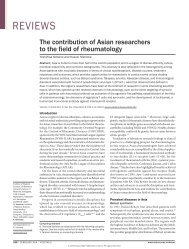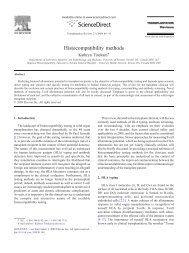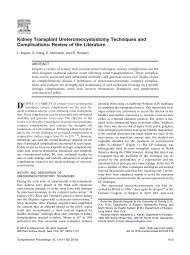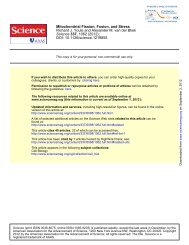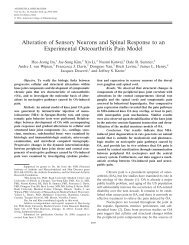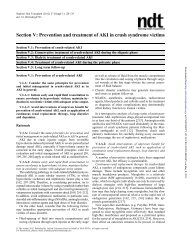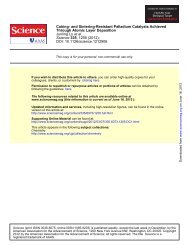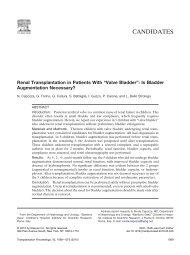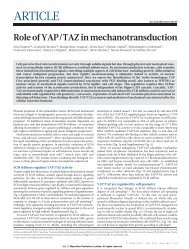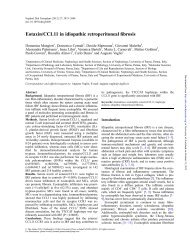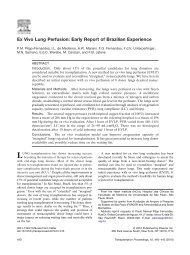Quantifying the material and structural determinants of bone strength
Quantifying the material and structural determinants of bone strength
Quantifying the material and structural determinants of bone strength
Create successful ePaper yourself
Turn your PDF publications into a flip-book with our unique Google optimized e-Paper software.
M.L. Bouxsein, E. Seeman / Best Practice & Research Clinical Rheumatology 23 (2009) 741–753 743<br />
although DXA is currently <strong>the</strong> gold st<strong>and</strong>ard for clinical assessment <strong>of</strong> fracture risk, its shortcomings<br />
are increasingly being recognised.<br />
DXA in <strong>the</strong> assessment <strong>of</strong> <strong>bone</strong> structure d hip <strong>structural</strong> analysis (HSA)<br />
Bone geometry, an important determinant <strong>of</strong> <strong>bone</strong> <strong>strength</strong>, has been assessed non-invasively by<br />
several methods including radiogrammetry, automated DXA-based analysis <strong>of</strong> X-ray attenuation<br />
pr<strong>of</strong>iles (termed ‘hip <strong>structural</strong> analysis’, HSA) <strong>and</strong> 3D imaging methods such as computed tomography<br />
or magnetic resonance imaging.<br />
HSA has been widely used because <strong>structural</strong> properties can be estimated from routine DXA scans, <strong>and</strong><br />
<strong>the</strong> s<strong>of</strong>tware needed to compute <strong>the</strong>se variables is now provided by several <strong>of</strong> <strong>the</strong> DXA manufacturers.<br />
HSA uses data from 2D DXA scans to derive measurements <strong>of</strong> <strong>bone</strong> geometry at <strong>the</strong> proximal femur,<br />
including <strong>the</strong> amount <strong>and</strong> distribution <strong>of</strong> <strong>bone</strong> mass, <strong>bone</strong> morphology <strong>and</strong> indices <strong>of</strong> <strong>bone</strong> <strong>strength</strong> such<br />
as section modulus (an index <strong>of</strong> resistance to bending), buckling ratio <strong>and</strong> <strong>bone</strong> area (an index <strong>of</strong><br />
resistance to compression) [20]. However, some <strong>of</strong> <strong>the</strong>se indices are derived under <strong>the</strong> assumption that<br />
<strong>the</strong> <strong>bone</strong> cross section is circular at <strong>the</strong> femoral neck <strong>and</strong> shaft, <strong>and</strong> elliptical at <strong>the</strong> inter-trochanteric<br />
region, that <strong>the</strong> tissue mineral density is constant <strong>and</strong> that cortical <strong>and</strong> trabecular <strong>bone</strong> in <strong>the</strong> cross<br />
section are a constant proportion [21]. Moreover, <strong>the</strong> method is limited to analyses <strong>of</strong> a single plane.<br />
HSA has been used to examine effects <strong>of</strong> anti-resorptive <strong>and</strong> anabolic <strong>the</strong>rapies on femoral<br />
geometry [21–25]. However, anti-resorptive <strong>the</strong>rapies increase tissue mineral density [26–29],<br />
whereas teriparatide may decrease it [30]. An increase in <strong>the</strong> amount <strong>of</strong> mineral per unit <strong>bone</strong> volume<br />
is ‘seen’ by HSA as an increase in <strong>the</strong> cross-sectional area <strong>of</strong> <strong>bone</strong> <strong>material</strong>, leading an investigator to<br />
infer that <strong>the</strong>re has ei<strong>the</strong>r been periosteal apposition <strong>and</strong>/or endocortical apposition produced by<br />
antiresorptive agents; effects that are not produced by this class <strong>of</strong> drug. Thus, interpretation <strong>of</strong> HSA<br />
from studies where mineralisation density changes is difficult <strong>and</strong> suspect.<br />
Several studies have used this method to provide information regarding age-, race- <strong>and</strong> sex-related<br />
differences in femoral geometry that may contribute to hip fracture risk [31–39]; effects <strong>of</strong> physical<br />
activity <strong>and</strong> hormone status on femoral geometry [40,41]; <strong>and</strong> genetic <strong>determinants</strong> <strong>of</strong> femoral<br />
structure [42–44]. Because some <strong>of</strong> <strong>the</strong> assumptions underlying HSA have not been tested across ages<br />
<strong>and</strong> populations, conclusions from <strong>the</strong>se studies should be viewed with caution.<br />
Several prospective studies report that HSA-derived measures <strong>of</strong> femoral geometry are associated<br />
with risk <strong>of</strong> hip fracture [45–48]. However, it is unclear whe<strong>the</strong>r HSA provides information about<br />
fracture risk that is independent <strong>of</strong> BMD. This is likely because femoral BMD <strong>and</strong> HSA-derived <strong>structural</strong><br />
properties are highly correlated because <strong>the</strong> same attenuation pr<strong>of</strong>ile is used to compute <strong>the</strong><br />
measurements. Thus, conclusions regarding independent contributions <strong>of</strong> <strong>bone</strong> density <strong>and</strong> geometry<br />
to femoral fragility are problematic using HSA.<br />
We do not recommend <strong>the</strong> use <strong>of</strong> this technique because <strong>of</strong> <strong>the</strong> uncertainties <strong>and</strong> <strong>the</strong> potentially<br />
misleading notions <strong>of</strong> <strong>bone</strong> physiology that can arise if <strong>the</strong> results are accepted on face value. Moreover,<br />
o<strong>the</strong>r options are available for directly measuring <strong>the</strong> 3D geometry, such as magnetic resonance<br />
imaging (MRI), computed tomography (CT) <strong>and</strong> high-resolution peripheral quantitative computed<br />
tomography (HR-pQCT). These are being used in clinical studies to identify <strong>the</strong> relationships between<br />
geometry, <strong>bone</strong> density <strong>and</strong> fracture risk.<br />
Quantitative computed tomography (QCT)<br />
In QCT, <strong>the</strong> X-ray source <strong>and</strong> detector rotate in synchronised fashion around <strong>the</strong> subject. Algorithms<br />
are used to reconstruct <strong>the</strong> attenuation data into 3D images. Use <strong>of</strong> a <strong>bone</strong> mineral (or hydroxyapatite)<br />
phantom allows calibration <strong>of</strong> <strong>the</strong> data, providing a measurement <strong>of</strong> <strong>bone</strong> density that is independent<br />
<strong>of</strong> <strong>bone</strong> size. The cortical <strong>and</strong> trabecular compartments are measured separately (Fig. 1). QCT-based<br />
<strong>bone</strong> measurements have been used to evaluate sex-, age- <strong>and</strong> ethnic-related differences in vertebral<br />
<strong>and</strong> femoral geometry <strong>and</strong> density, providing insights into <strong>the</strong> development <strong>of</strong> skeletal fragility [49–<br />
52]. As <strong>the</strong> variance in measures <strong>of</strong> vBMD by QCT are greater than by using DXA, particularly for<br />
cancellous <strong>bone</strong>, changes expressed in percentage terms are greater than changes observed by DXA.<br />
Accelerated decrease in trabecular <strong>bone</strong> is observed with greater decreases in women than men in


